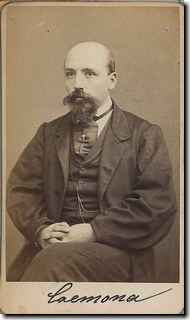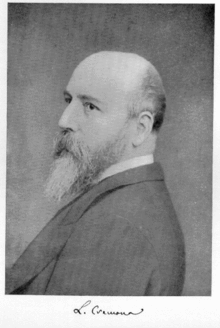<Back to Index>
- Mathematician Luigi Cremona, 1830
- Composer Pietro Antonio Stefano Mascagni, 1863
- 6th Prime Minister of Australia Joseph Cook, 1860
PAGE SPONSOR


Luigi Cremona (7 December 1830 – 10 June 1903) was an Italian mathematician. His life was devoted to the study of geometry and reforming advanced mathematical teaching in Italy. His reputation mainly rests on his Introduzione ad una teoria geometrica delle curve piane. He notably enriched our knowledge of algebraic curves and algebraic surfaces.
Luigi Cremona was born in Pavia (Lombardy), then part of the Austrian controlled Kingdom of Lombardy - Venetia.
In 1848, when Milan and Venice rose against Austria, Cremona, then only seventeen, joined the ranks of the Italian volunteers. He remained with them, fighting on behalf of his country's freedom, until, in 1849, the capitulation of Venice put an end to the campaign.
He then returned to Pavia, where he pursued his studies at the university under Francesco Brioschi, and determined to seek a career as teacher of mathematics. His first appointment was as elementary mathematical master at the gymnasium and lyceum of Cremona, and he afterwards obtained a similar post at Milan. In 1860 he was appointed to the professorship of higher geometry at the University of Bologna, and in 1866 to that of higher geometry and graphical statics at the higher technical college of Milan. In this same year he competed for the Steiner Prize of the Berlin Academy, with a treatise entitled Memoria sulle superfici del terzo ordine, and shared the award with J.C.F. Sturm. Two years later the same prize was conferred on him without competition.
In 1873 he was called to Rome to organize the college of engineering, and was also appointed professor of higher mathematics at the university. Cremona's reputation had now become European, and in 1879 he was elected a corresponding member of the Royal Society. In the same year he was made a senator of the Kingdom of Italy.
As early as 1856 Cremona had begun to contribute to the Annali di scienze matematiche e fisiche, and to the Annali di matematica, of which he became afterwards joint editor. Papers by him appeared in the mathematical journals of Italy, France, Germany and England, and he published several important works, many of which have been translated into other languages. His manual on Graphical Statics and his Elements of Projective Geometry (translated by C. Leudesdorf), have been published in English by the Clarendon Press.